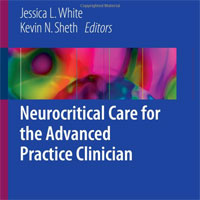Stories Category: Intensive Care
Lower or Higher Oxygenation Targets in the ICU
This study reported no overall differences comparing a PaO2 target of 8–12 kPa on mortality or days alive without life support in 90 days. Subgroup analyses suggested heterogeneity of treatment effects (HTE) in patients... read more
Tailoring Antithrombotic Treatment in Patients with Acute Myocardial Infarction and Cancer
For more than two decades, dual platelet antiplatelet therapy (DAPT) has been one of the mainstays in the treatment of patients who have suffered an acute myocardial infarction (AMI) or undergoing percutaneous coronary intervention... read more

Neurocritical Care for the Advanced Practice Clinician
By utilizing a review of case-based studies and providing concise management recommendations from leaders in the field, this book provides essential knowledge for those practicing in a dynamic specialty. In the rapidly... read more
Trends in Empiric Broad-Spectrum Antibiotic Use for Suspected Community-Onset Sepsis in US Hospitals
Empiric treatment for suspected community-onset sepsis accounts for about half of broad-spectrum antibiotic use in US hospitals even though resistant organisms are isolated in only 7% of patients with community-onset sepsis... read more
Complex Infusion Volumes Interaction and Confounding Factors with Lactate Clearance in Septic Shock
A recent article by Ahlstedt et al. published in Intensive Care Medicine examining the impact of restrictive fluid management on lactate clearance in septic shock patients within the intensive care unit (ICU) piqued our interest.... read more

Quick Reference to Critical Care
Sharpen your critical care skills, with the fully updated Quick Reference to Critical Care, fifth 5th edition. This well-illustrated pocket guide covers the full range of critical care scenarios, listing each disorder, medication,... read more
Ketamine Can Be a Transformational Agent But Not Without Risk or Danger
Ketamine is growing as a tool in the world of emergency medicine, offering a broad spectrum of applications that underscore its pivotal role in modern therapeutic regimens. It is increasingly being recognized for its... read more
Sepsis Alert Systems, Mortality, and Adherence in Emergency Departments
This systematic review and meta-analysis demonstrated the significant association of implementing sepsis alert systems in the Emergency Departments (ED) with patient outcomes. These findings indicate that sepsis alert... read more
Navigating the Complexity of ECMO and Positioning in ARDS Treatment
We read with great interest the network meta-analysis by Sud et al. comparing venovenous extracorporeal membrane oxygenation (VV-ECMO), prone positioning, and supine mechanical ventilation in patients with severe hypoxemic... read more
Genetic Testing in Early-onset Atrial Fibrillation
Atrial fibrillation (AF) is a globally prevalent cardiac arrhythmia with significant genetic underpinnings, as highlighted by recent large-scale genetic studies. A prominent clinical and genetic overlap exists between... read more

EKG/ECG Interpretation Made Easy
In this guide, you will understand how ECGs are performed, what they represent about the heart, and what it means to see something you don't think is normal. Before you get into the hard stuff—the actual interpretation... read more
Trauma Medical Home: New Coordinated Care Model for Injured Older Adults
Older adults who suffer serious injuries from a fall or a motor vehicle accident often have impaired long-term functioning and diminished quality of life. A new study, published in JAMA Surgery by researcher-clinicians... read more
Treatment of Refractory Cardiac Arrest by Controlled Reperfusion of the Whole Body
This multicenter, prospective, all-comers observational study has provided preliminary data on a new approach to treat patients with prolonged refractory CA and CCPR by applying an advanced extracorporeal perfusion circuit,... read more
Antifungal Prophylaxis of COVID-19 Associated Pulmonary Aspergillosis in Ventilated Patients
This study investigated the impact of POSA prophylaxis on risk of CAPA development in mechanically ventilated COVID-19 patients receiving corticosteroids. We observed a significant variation in CAPA incidence rates among... read more
High-flow Nasal Cannula Oxygen vs. NIV in AHF-related ARF
In this pilot study, we did not observe a statistically significant difference in changes in respiratory rate among patients with acute respiratory failure (ARF) due to acute heart failure (AHF) and managed with high-flow... read more
Another Perspective on Tidal Volume: From Statistics to Uncertainty
We have read with great interest the recent editorial by Pellegrini et al. Undoubtedly, now more than ever, we have begun to question the true role of tidal volume (VT) in acute respiratory distress syndrome (ARDS). As... read more
Vasoconstriction in Septic Shock
Septic shock is associated with endothelial dysfunction leading to arterial and venous dilation, alterations in regional blood flow distribution, and microcirculatory disturbances. Fluids and vasopressors are the key... read more






